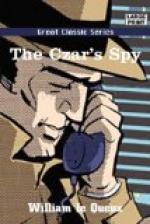Who was the man who, having represented the man now before me, had been struck dead by an unerring hand? Was it possible that Armida had been called by telegram to meet her husband, and recognizing the fraud perpetrated upon her threatened to disclose it and, for that reason, shared the same fate as the masquerader?
This was the first theory that occurred to me; one which I believed to be the correct one. The motive was a mystery, yet the facts seemed to me plain enough.
As the young Italian had refused to give any satisfactory explanation, I resolved within myself to wait until the unfortunate woman’s body was recovered before revealing to him the ghastly truth. Without doubt he had some reason in withholding from me the true facts, either because he feared that I might become unduly alarmed, or else he himself had been deeply implicated in the plot. Of the two suggestions, I was inclined to believe in the latter.
He walked with me as far as the end of Bishop’s Road, endeavoring with all the Italian’s exquisite diplomacy to obtain from me what I knew concerning the Leithcourts. But I told him nothing, nor did I reveal that I had only that morning returned from Scotland. Then at last we parted, and he retraced his steps to the little restaurant in Westbourne Grove, while I entered a hansom and drove to the well-known photographer’s in New Bond Street, whose name had been upon the torn photograph of the young girl in the white pique blouse and her hair fastened with a bow of black ribbon, the picture that I had found on board the Lola on that memorable night in the Mediterranean, and a duplicate of which I had seen in Muriel’s cosy little room up at Rannoch.
I recollected that she had told me the name of the original was Elma Heath, and that she had been a schoolfellow of hers at Chichester. Therefore I inquired of the photographer’s lady-clerk whether she could supply me with a print of the negative.
For a considerable time she searched in her books for the name, and at last discovered it. Then she said:
“I regret, sir, that we can’t give you a print, for the customer purchased the negative at the time.”
“Ah, I’m very sorry for that,” I said. “To what address did you send it?”
“The customer who ordered it was apparently a foreigner,” she said, at the same time turning round the ledger so that I could read. And I saw that the entry was: “Heath—Miss Elma—3 dozen cabinets and negative. Address: Baron Xavier Oberg, Vosnesenski Prospect 48, St. Petersburg, Russia.”
“Did this gentleman come with the young lady when her portrait was taken?” I inquired.
“I can’t tell, sir,” she replied. “I’ve only been here a year, and you see the date—over two years ago.”
“The photographer would know, perhaps?”
“He’s a new man, sir. He only came a month ago. In fact, the business changed hands a year ago, and none of the previous employees have remained.”




